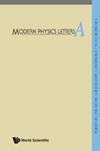马德尔宇宙的查里斯全息暗能量行为
IF 1.5
4区 物理与天体物理
Q3 ASTRONOMY & ASTROPHYSICS
引用次数: 0
摘要
在这项研究中,在[公式:见正文]引力理论的框架内,考虑到均质和各向异性的马德尔宇宙,讨论了查里斯全息暗能量(THDE)。哈勃视界被视为系统的红外截止点。为了得到场方程,使用了 THDE 密度和各向异性参数的解。此外,还研究了各种物理参数,如减速参数、各向异性参数和体积。还借助图形对它们进行了直观检验。其中提到了与不同观测数据相一致的不同减速参数值。除此以外,还分析了宇宙学参数,如抽搐参数、lerk 参数和快变参数。还研究了状态探测器诊断法,它是分离暗能量模型的有用工具。通过计算和表示总体密度参数([公式:见正文]),可以得出结论:模型的各向异性消失了,显示出与当前宇宙一致的各向同性趋势。最后,结合相关研究和观测结果,对模型的物理和几何性质进行了研究。本文章由计算机程序翻译,如有差异,请以英文原文为准。
Behavior of Tsallis holographic dark energy for Marder universe
In this study, Tsallis holographic dark energy (THDE) was discussed within the frame of [Formula: see text] gravitational theory and considering the homogeneous and anisotropic Marder universe. The Hubble horizon was taken into consideration as infrared cutoff of the system. To get the field equations, solutions were used for the THDE density and the anisotropy parameter. Furthermore, a variety of physical parameters such as deceleration parameter, anisotropy parameter and volume have been examined. They have been also been visually examined with the help of graphics. Different values of deceleration parameter consistent with different observational data were mentioned. In addition to this, cosmological parameters like jerk, lerk and snap parameters were analyzed. Statefinder diagnostics which are helpful tools for the separation of dark energy models have been examined. By the calculation and representation of the overall density parameter ([Formula: see text]) it can be concluded that the anisotropic nature of model vanishes showing a tendency to isotropy in accordance with present universe. Finally, the physical and geometrical nature of the model was studied, collating with relevant studies and observations.
求助全文
通过发布文献求助,成功后即可免费获取论文全文。
去求助
来源期刊

Modern Physics Letters A
物理-物理:核物理
CiteScore
3.10
自引率
7.10%
发文量
186
审稿时长
3 months
期刊介绍:
This letters journal, launched in 1986, consists of research papers covering current research developments in Gravitation, Cosmology, Astrophysics, Nuclear Physics, Particles and Fields, Accelerator physics, and Quantum Information. A Brief Review section has also been initiated with the purpose of publishing short reports on the latest experimental findings and urgent new theoretical developments.
 求助内容:
求助内容: 应助结果提醒方式:
应助结果提醒方式:


